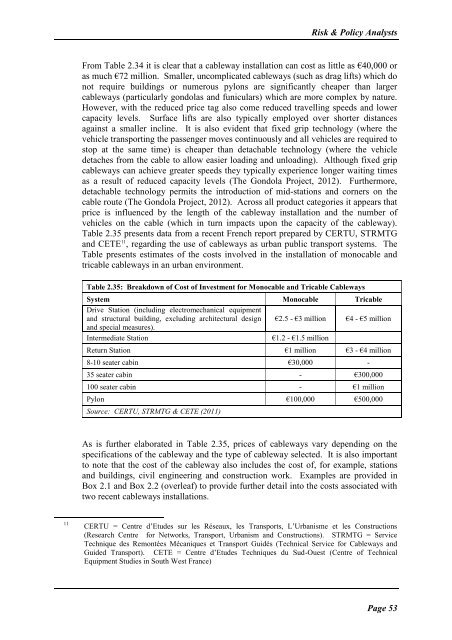Cableways Impact Assessment Study - Final Report - saferail.nl
Cableways Impact Assessment Study - Final Report - saferail.nl
Cableways Impact Assessment Study - Final Report - saferail.nl
Create successful ePaper yourself
Turn your PDF publications into a flip-book with our unique Google optimized e-Paper software.
Risk & Policy Analysts<br />
From Table 2.34 it is clear that a cableway installation can cost as little as €40,000 or<br />
as much €72 million. Smaller, uncomplicated cableways (such as drag lifts) which do<br />
not require buildings or numerous pylons are significantly cheaper than larger<br />
cableways (particularly gondolas and funiculars) which are more complex by nature.<br />
However, with the reduced price tag also come reduced travelling speeds and lower<br />
capacity levels. Surface lifts are also typically employed over shorter distances<br />
against a smaller incline. It is also evident that fixed grip technology (where the<br />
vehicle transporting the passenger moves continuously and all vehicles are required to<br />
stop at the same time) is cheaper than detachable technology (where the vehicle<br />
detaches from the cable to allow easier loading and u<strong>nl</strong>oading). Although fixed grip<br />
cableways can achieve greater speeds they typically experience longer waiting times<br />
as a result of reduced capacity levels (The Gondola Project, 2012). Furthermore,<br />
detachable technology permits the introduction of mid-stations and corners on the<br />
cable route (The Gondola Project, 2012). Across all product categories it appears that<br />
price is influenced by the length of the cableway installation and the number of<br />
vehicles on the cable (which in turn impacts upon the capacity of the cableway).<br />
Table 2.35 presents data from a recent French report prepared by CERTU, STRMTG<br />
and CETE 11 , regarding the use of cableways as urban public transport systems. The<br />
Table presents estimates of the costs involved in the installation of monocable and<br />
tricable cableways in an urban environment.<br />
Table 2.35: Breakdown of Cost of Investment for Monocable and Tricable <strong>Cableways</strong><br />
System Monocable Tricable<br />
Drive Station (including electromechanical equipment<br />
and structural building, excluding architectural design €2.5 - €3 million €4 - €5 million<br />
and special measures).<br />
Intermediate Station<br />
€1.2 - €1.5 million<br />
Return Station €1 million €3 - €4 million<br />
8-10 seater cabin €30,000 -<br />
35 seater cabin - €300,000<br />
100 seater cabin - €1 million<br />
Pylon €100,000 €500,000<br />
Source: CERTU, STRMTG & CETE (2011)<br />
As is further elaborated in Table 2.35, prices of cableways vary depending on the<br />
specifications of the cableway and the type of cableway selected. It is also important<br />
to note that the cost of the cableway also includes the cost of, for example, stations<br />
and buildings, civil engineering and construction work. Examples are provided in<br />
Box 2.1 and Box 2.2 (overleaf) to provide further detail into the costs associated with<br />
two recent cableways installations.<br />
11<br />
CERTU = Centre d’Etudes sur les Réseaux, les Transports, L’Urbanisme et les Constructions<br />
(Research Centre for Networks, Transport, Urbanism and Constructions). STRMTG = Service<br />
Technique des Remontées Mécaniques et Transport Guidés (Technical Service for <strong>Cableways</strong> and<br />
Guided Transport). CETE = Centre d’Etudes Techniques du Sud-Ouest (Centre of Technical<br />
Equipment Studies in South West France)<br />
Page 53
















